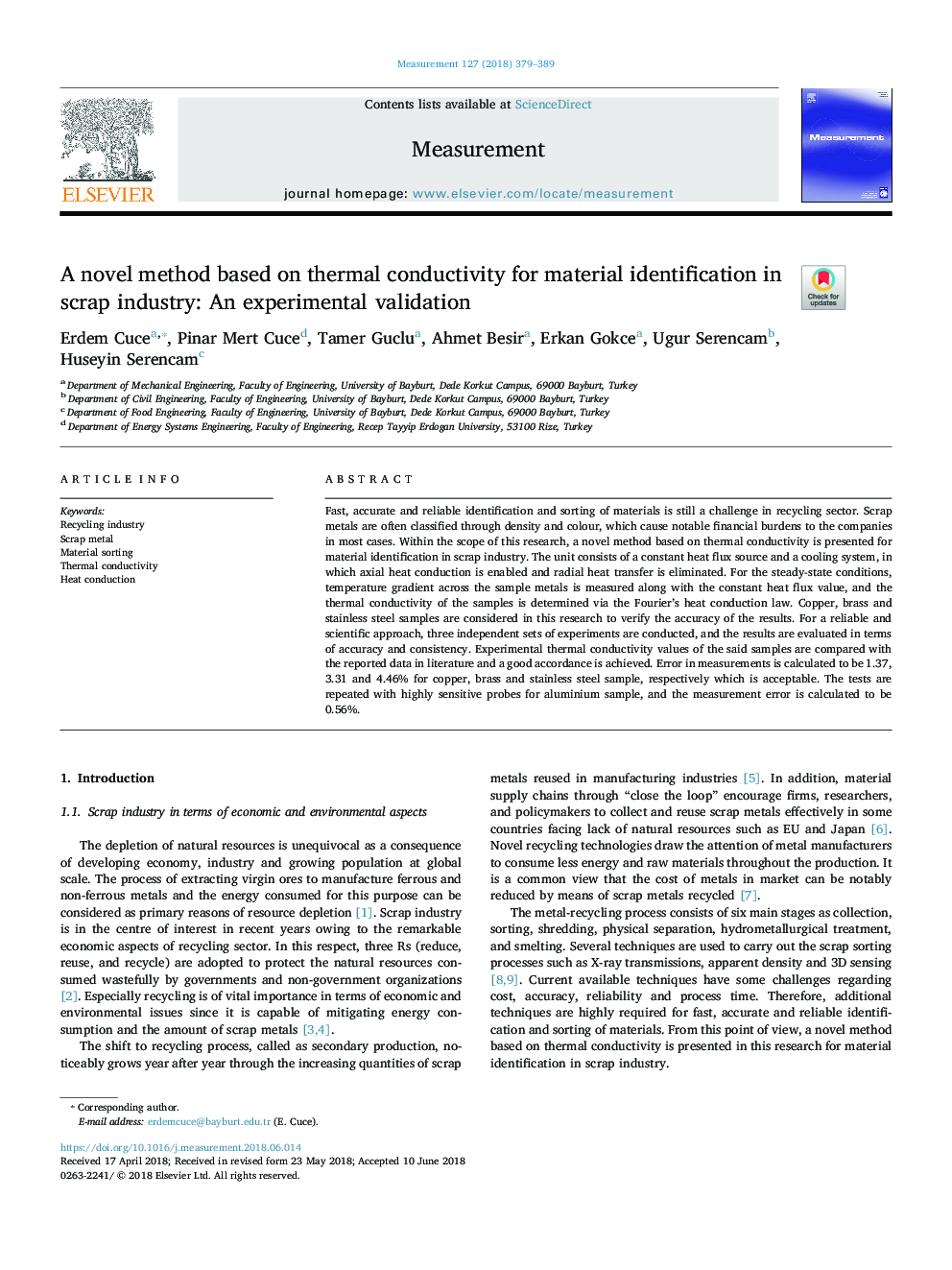| کد مقاله | کد نشریه | سال انتشار | مقاله انگلیسی | نسخه تمام متن |
|---|---|---|---|---|
| 7120596 | 1461460 | 2018 | 11 صفحه PDF | دانلود رایگان |
عنوان انگلیسی مقاله ISI
A novel method based on thermal conductivity for material identification in scrap industry: An experimental validation
ترجمه فارسی عنوان
یک روش جدید مبتنی بر هدایت حرارتی برای شناسایی مواد در صنایع قراضه: یک اعتبار آزمایشی
دانلود مقاله + سفارش ترجمه
دانلود مقاله ISI انگلیسی
رایگان برای ایرانیان
کلمات کلیدی
صنعت بازیافت اهن قراضه، دسته بندی مواد، هدایت حرارتی، انتقال حرارت،
ترجمه چکیده
شناسایی و مرتب سازی سریع، دقیق و قابل اطمینان از مواد هنوز یک چالش در بخش بازیافت است. فلزات قراضه اغلب از طریق تراکم و رنگ طبقه بندی می شوند که در اکثر موارد باعث می شود که مالیات قابل توجهی به شرکتها برسد. در محدوده این تحقیق، یک روش جدید مبتنی بر هدایت حرارتی برای شناسایی مواد در صنعت ضایعات ارائه شده است. این واحد شامل یک منبع شار حرارتی ثابت و یک سیستم خنک کننده است که در آن هدایت گرمای محوری فعال و انتقال حرارت شعاعی حذف می شود. برای حالت های حالت پایدار، گرادیان درجه حرارت در سراسر فلزات نمونه همراه با مقدار جریان شار حرارت ثابت و هدایت حرارتی نمونه ها از طریق قانون هدایت گرما فوریه تعیین می شود. نمونه های مس، برنج و فولاد ضد زنگ در این تحقیق مورد بررسی قرار می گیرند تا دقت نتایج را بررسی کنند. برای یک رویکرد قابل اعتماد و علمی، سه مجموعه مستقل از آزمایشات انجام می شود و نتایج حاصل از نظر دقت و صحت ارزیابی می شود. مقادیر هدایت حرارتی آزمایشی نمونه ها با داده های گزارش شده در ادبیات مقایسه شده و برآورده شده است. خطای اندازه گیری ها به ترتیب 1.37، 3.31 و 4.46٪ برای نمونه های مس، برنج و فولاد ضد زنگ محاسبه می شود که قابل قبول است. آزمایشات با پروب بسیار حساس برای نمونه آلومینیومی تکرار شده و خطای اندازه گیری به میزان 0.56٪ محاسبه می شود.
موضوعات مرتبط
مهندسی و علوم پایه
سایر رشته های مهندسی
کنترل و سیستم های مهندسی
چکیده انگلیسی
Fast, accurate and reliable identification and sorting of materials is still a challenge in recycling sector. Scrap metals are often classified through density and colour, which cause notable financial burdens to the companies in most cases. Within the scope of this research, a novel method based on thermal conductivity is presented for material identification in scrap industry. The unit consists of a constant heat flux source and a cooling system, in which axial heat conduction is enabled and radial heat transfer is eliminated. For the steady-state conditions, temperature gradient across the sample metals is measured along with the constant heat flux value, and the thermal conductivity of the samples is determined via the Fourier's heat conduction law. Copper, brass and stainless steel samples are considered in this research to verify the accuracy of the results. For a reliable and scientific approach, three independent sets of experiments are conducted, and the results are evaluated in terms of accuracy and consistency. Experimental thermal conductivity values of the said samples are compared with the reported data in literature and a good accordance is achieved. Error in measurements is calculated to be 1.37, 3.31 and 4.46% for copper, brass and stainless steel sample, respectively which is acceptable. The tests are repeated with highly sensitive probes for aluminium sample, and the measurement error is calculated to be 0.56%.
ناشر
Database: Elsevier - ScienceDirect (ساینس دایرکت)
Journal: Measurement - Volume 127, October 2018, Pages 379-389
Journal: Measurement - Volume 127, October 2018, Pages 379-389
نویسندگان
Erdem Cuce, Pinar Mert Cuce, Tamer Guclu, Ahmet Besir, Erkan Gokce, Ugur Serencam,
